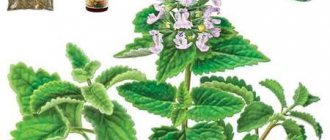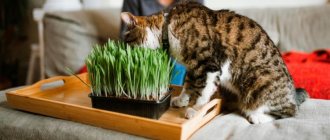Contraindications and restrictions
Veterinarians do not recommend giving catnip to pregnant females. Under the influence of essential oil, the animal may experience severe agitation. This quickly depletes the cat's nervous system. Stress during pregnancy has an extremely negative impact on the condition of the mother of the offspring. Before the kittens appear, it is better to remove the pot with the plant. However, it is worth taking into account the animal’s intuitive sense. If your cat goes outside and starts sniffing mint, you shouldn’t stop her from doing so.
Another contraindication is the animal’s uncontrolled behavior after eating grass. If a cat, after eating or sniffing, becomes agitated and aggressive or falls into a stupor, you should not give it grass.
Contraindications
People who have been diagnosed with the following diseases should avoid consuming catnip:
- severe heart disease;
- gastritis with high acidity;
- tachycardia.
You cannot take budra and drugs based on it even in small doses during pregnancy and breastfeeding.
Overdose or too frequent consumption of catnip can lead to increased heart rates and the development of cardiac diseases.
The plant is absolutely safe for cats. Unless your pet eats too much of this fragrant herb, his intestines may become upset for a short time.
Types of catnip
Catnip is sold in pet supply stores and comes in different forms.
Tablets and vitamins
An excellent addition to cat food are tablets and vitamins that contain catnip. They have a beneficial effect on the nervous system and enrich the body with useful substances. The smell of nepetalactone encourages the cat to eat the whole complex of vitamins with pleasure.
You can easily purchase fortified treats in specialized stores. Various manufacturers offer their products.
Vitamins with catnip
Sprays and drops
Products with a fairly long shelf life are sprays and drops for cats. They are used to attract pets to the required place. These substances can be sprayed as needed.
Incense sticks for chewing
If it is difficult for your cat to get used to brushing its teeth, then a chewing stick with mint will come to the rescue. Over time, you can use regular remedies.
As part of scented toys
Scented toys contain the scent of cat weed. They are very attractive to furry pets. When purchasing, you should study the label. It is good that only leaves and flowers are used when filling, and not tough stems. Low-quality fillers only add volume and do not have the desired effect.
Toys with grass sewn inside can be very different in shape and color. For example, mice, balls, bananas, etc. They promote active play of animals.
Soap bubbles with an extract of mint essential oils are also intended for the game.
Over time, the smell of catnip weakens. To ensure that your animal continues active play with its favorite toy, you can spray mint on it in the form of a spray. The cat will again react to the forgotten item and show keen interest.
You can buy quality weed in bulk and fill the toys with it yourself. You should beware of tough plant stems, especially if your cat likes to chew on them. The animal may get hurt.
Experienced breeders advise buying several fur mice and placing them in a container with grass from time to time. The toys will acquire the smell of real mint, and cats will be happy to play with them.
Toys for cats
Additional Information! There are many different types of catnip. If desired, it can be grown at home on a windowsill or in the garden. The plant is unpretentious, quickly accepted, and reproduces well. Seedlings can be bought at the market or in a specialty store.
Catnip will be fun for your pet on a walk. The owners can have fun watching his behavior. Please note that the plant will also attract neighboring cats.
Catmint (Nepetia Cataria) - what kind of plant is it?
This species has several common names: catnip, catnip, lemongrass. It is a herbaceous plant belonging to the Lamiaceae family.
Common catnip
In the wild, this grass can be found in almost all regions of Russia. She is like a weed, she lives everywhere: in forests, fields and meadows. The herb is endowed with an easily perceptible pleasant aroma, consisting of a bouquet of rose and lemon scents.
Brief description of what it looks like
Many people don’t know: what is catnip? The species belongs to simple perennials. Grows in literally any soil. Externally it is presented in the form of an erect, woody stem with a small edge. The ovoid-shaped leaf blades are surrounded by dense inflorescences that look like a semi-umbrella. The flowers are painted pale blue.
Catnip inflorescences
The root system is very powerful and has a branched structure. The flowering period is short - from June to the end of July. The plant contains the following substances in large quantities:
- nepetalactone;
- glycoside;
- saponin;
- tannins;
- ascorbic acid.
Essential oils are contained only in the leaves; the concentration in the stems is close to zero.
On a note! Often inexperienced gardeners confuse catnip with lemon balm. Both types have a similar appearance and a similar aroma. But still, cats, unlike humans, have a sharper sense of smell and will never confuse them.
What is the difference from regular mint
It is quite easy to externally confuse ordinary peppermint and lemongrass. Although the species will look the same, they are still completely different species in structure and composition. The main difference is that in ordinary mint the main active ingredient is menthol, and in catmint it is nepetalactone.
Peppermint
Despite their external similarity, the plants will differ in smell. Catnip has a tart lemony smell, and mint has a specific menthol aroma.
Another difference between the crops is that the aroma of the cat species attracts all kinds of garden insects, but mosquitoes and cockroaches cannot tolerate it.
catnip
Ordinary mint is not endowed with such features.
Useful properties of catnip
Before giving catnip to your pet, you need to familiarize yourself with its beneficial and harmful qualities.
With the help of catnip, breeders often correct the behavior of their pets. In case of aggressive behavior, the use of this drug helps to quickly calm the cat. To speed up the process, special sprays are used, the main active ingredient of which is nepetalactone.
If an animal is depressed, you can use catnip to “wake up” activity. The cat will instantly become cheerful and friendly. The effect of this herb on the cat’s nervous system depends on the individual characteristics of the particular pet’s body.
On a note! Often the “cat delicacy” is used not only to correct the animal’s behavior, but also to teach the pet useful and much-needed skills.
The flower also has an excellent antibacterial effect. When eaten, mint not only cleanses the intestines of all kinds of bacteria, but also helps improve peristalsis. Catnip is also an excellent anthelmintic.
Breeders recommend using this particular herb in the following situations:
- for treating cats against such dangerous parasites;
- to reduce the consequences of any stressful situation;
- to increase feelings of hunger and improve appetite;
- as an assistant for accustoming an animal to a tray or place to sleep.
But like any potent drug, mint can not only help, but also harm the cat. Experts categorically do not recommend treating pregnant or lactating cats with catnip. Overstimulation can lead to unknowing harm to the offspring. It is important to carefully monitor your pet's behavior under the influence of nepetalactone. At the slightest deviation from the norm, veterinarians recommend refusing to use catnip.
Application area
People have many questions: is catnip healthy, what is it for, where and how to use it. Veterinarians often use catnip to calm pets. This is a natural remedy that allows you to correct the animal's behavior pattern. Unlike synthetic sedatives, it does not have a negative effect on your pet and does not cause side effects.
The plant has the following benefits for cats:
- for colds and stomach pain, essential oils and phytoncides have an antibacterial effect and relieve spasms;
- increases appetite, preventing exhaustion of the animal’s body during illness;
- helps you cope more easily with stress when moving, renovating or buying a new pet;
- Suitable as an antiparasitic agent as an additional therapy when taking a course of anthelmintic drugs.
The main advantage of a natural remedy is the lack of addiction in your pet. Despite the acute reaction of the nervous system, the period of excitation does not last long and passes without leaving a trace on the general condition of the animal.
Manufacturers of pharmaceutical companies that are focused on the production of veterinary drugs became interested in the unusual reaction of pets to mint. They have created a line of medicines with catnip essential oils, essences or liquid extracts. Veterinarians do not recommend giving dried parts of the plant and products with catnip more than once a week.
Concentrated solutions are used in the following cases:
- Control of aggressive behavior. An irritated pet should be given a plant leaf or a piece of cloth soaked in the extract. Nepetalactone contained in the oil has a sedative effect on the nervous system, which allows you to control the animal’s behavior.
- For cats with increased physical activity. If you give your cat a cloth or paper soaked in oil, he will calm down and stop running around the apartment, destroying fragile objects and scratching upholstered furniture. This technique helps in training kittens, which become calmer and more controlled as they grow older.
- Buying an adult animal. It is difficult to train cats and kittens over 1 year old to use a litter box. Therefore, owners often resort to using catnip. From 5 to 10 drops of liquid extract mixed with sand for the tray, a conditioned reflex is developed in the animal. Thanks to this, the cat will go to the litter box. A similar principle is used to accustom a pet to a new bed.
- If a cat uses upholstered furniture to sharpen its claws, special scratching posts are sprayed with catnip essence.
- You can fill soft toys or a ball with cotton wool soaked in the medicine. Thanks to this effect, the cat will not get bored in the absence of the owner and tear up the furniture. The cotton wool will need to be changed every month because the oils evaporate quickly. Ready-made toys with catnip are sold in pet stores.
- the reaction speed increases;
- memory improves;
- people become less irritable;
- cognitive functions increase;
- a person can more easily focus on the task at hand;
- the psycho-emotional state is normalized, resistance to stress increases.
In folk medicine, catnip is used to treat colds, migraines, and digestive problems. Women are advised to use horehound decoctions for painful menstruation. When used externally in the joint area, mint medicines help relieve inflammation and improve tissue microcirculation.
Bags of crushed and dried leaves of the plant can be hung around the apartment. Essential oils repel insects and small rodents, so there will be no pests in the house.
Why does this plant attract cats?
As you know, nature has endowed cats with a keen sense of smell with a special sensitivity to essential oils. And therefore, it has long been no secret why they are attracted to this particular herb. Namely, nepetalactone contained in it, which affects the neurons of the animal’s brain. It is difficult to predict a cat's reaction. An active animal can behave calmly, while a passive animal can begin to behave violently. Subsequently, the pet’s type of behavior may change briefly and hallucinations may occur.
Typically, signs of exposure last between five and ten minutes. An interesting fact is that if a cat sniffs grass, the effect will be stimulating. But when taken in food, the effect will be sedative.
Sensitivity to the smell of catnip does not appear until the twelfth week of a kitten’s life. It must be remembered that some individuals may be completely indifferent to the catnip. According to statistics, this herb does not cause any reaction in 20–30% of cats. This is due to the lack of receptors that are transmitted at the genetic level.
Purposes and features of application
The most common use of catnip is to correct an animal's behavior . An aggressive pet can become docile and phlegmatic, while a lethargic one can become playful and active . Catnip is an excellent anti-stress product. It is recommended to give it to the animal when changing the environment, going to the doctor, etc. This way, its behavior will be calm. You can also add a couple of leaves to your food. This will be a good prevention against parasites and will help normalize digestion and appetite.
It is advisable to use the drug no more than once a week for 20 minutes . It can be in the form of dried weed, spray, fresh leaves or drops. If you wish, you can grow catnip yourself at home. Catnip seeds are available at any gardening store.
If you need to train your pet to use a scratching post, catnip will also come to your aid. This device will prevent damage to furniture and wallpaper. It should be placed near the sleeping place, since after waking up, cats first stretch and begin to sharpen their claws. In order to attract your pet’s attention so that he is not distracted by foreign objects while scratching, you need to rub the scratching post with catnip or put a bag of grass under the upholstery.
Advantages and disadvantages
The positive features of using catnip in animals include:
- anti-stress effect;
- harmless to the stomach;
- beneficial effect on the body;
- more agreeable behavior.
The disadvantages include a ban on frequent use, since this plant is a mild narcotic, and the cat may become addicted to it. And as a result, a defensive reaction is developed, that is, the pet will stop paying attention to it. It is not recommended to give grass to pregnant cats, as this can have a negative impact on the pregnancy of kittens due to irritation of the nervous system.
Appropriate place
Catnip prefers sunny places; in the shade and partial shade its flowering becomes much poorer, so choose a well-lit area for planting. This plant also feels great in group plantings; it goes well with other flowers, as long as the soil is sandy and loose. Heavy fertile soils are completely unsuitable for catnip.
Catnip is very frost-resistant, so there is no need to additionally cover it for the winter or be afraid of strong winds and drafts; this flower doesn’t care about anything.
The only thing that should be taken into account when choosing a suitable location is the location of groundwater and it is better if the selected area is on a hill, then excess water will not stagnate near the roots.
Growing and storing catnip
Catnip is unpretentious, so it’s easy to organize a pot of healthy treats for your pet on the windowsill or allocate a bed in the country house or in the garden.
You can purchase catnip seeds or seedlings at garden stores. This plant is planted indoors in spring or autumn. The main condition for development is a sufficient amount of sunlight (if it is not enough, use a fluorescent lamp), otherwise the sprouts will turn out weak. Intensive watering is required only in the first 10–14 days, then you can wait for the soil to dry out by 5–8 cm. If the soil is too wet, the roots may rot, so you should not be zealous.
Catnip can grow indoors
Catnip is planted in open ground in the spring, immediately after the last frost. Leave about half a meter of space between the seeds and water for germination for the same 10 days. In most regions, catnip prefers well-lit places; this should also be taken into account when planning the location of the bed. Exceptions are areas with very hot and dry climates, where the sun at its zenith can damage the leaves - in this case, the area should be shaded in the afternoon.
You can plant catnip in open ground
Catnip can also be planted from seedlings - this method is preferable for obtaining strong, viable plants. In this case, the seeds are planted in early April to a depth of no more than a centimeter. Two weeks later, when the first true leaves appear, picking is done (plants are transplanted at a young age) and the seedlings are transplanted into separate pots. By May, the height of the seedlings reaches 10–12 cm, at least 3 pairs of leaves appear - this is the time of planting in open ground.
It is good to plant catnip from seedlings
Helpful Tips:
- When grown in the garden, catnip grows well, and there is a chance of getting a persistent aggressive weed. Therefore, when selecting a bed on a site, it is advisable to plan it separately from other crops and fence it with stones;
- A good idea is to plant catnip in garden containers that can be buried in the ground. Shoots that escape beyond its boundaries can be easily tracked and weeded out, and the roots will not spread to the rest of the site;
- if you remove faded flowers and cut the grass, the plants will become bushier and will bloom more often;
- To propagate catnip, you can divide the root system. To do this, you need to dig up several shoots, lower their roots into water and wait until the root ball is saturated. Then you need to divide it in half and plant it. This procedure will also prevent the plants from growing too vigorously;
- Overwatering is more critical for catnip than underwatering, so in indoor conditions it is better to use light, well-drained soil and check with your finger that the soil is dry before watering.
Collection and drying of catnip is carried out in the fresh air. You can trim individual leaves at the points of attachment to the trunk (useful for speeding up the growth of the plant), branches at the base, or take the entire bush. The most convenient way to dry catnip is on paper towels in a well-lit place; whole plants can be hung upside down. It is unacceptable to lay out the grass in armfuls: it will lose all its beneficial properties.
Dried catnip can be stored for about 2 years.
Over time, essential oils dissipate, so it is important to keep it in the refrigerator or other cool place in an airtight container or bag. You can grind the dry leaves in a coffee grinder or food mill and store them in glass jars with tight-fitting lids.
If you just want to try offering catnip to your pet without fussing with planting, buy it dried at a pet store. Sprays and aerosols based on the plant and various toys with its addition are usually sold there.
Well, if ready-made toys do not warm your soul, the assortment of a pet store can be used as inspiration for creativity: for a simple bag, a handful of dry catnip, a scrap of fabric and minimal sewing skills are enough.
Reviews
Indeed, this herb works wonders for cats. It’s very good to take it with you on the road when you go to an exhibition.
Asia
https://mauforum.ru/viewtopic.php?f=37&t=3273&start=10
Catnip is “catnip.” The effect of “catnip” begins in the animal with euphoria, and then turns into a burst of energy. Cats should not eat it. Contains hallucinogens.
Nina and Britney
https://www.britishcat.ru/forumnew/printthread.php?t=3632&pp=40
The herb is harmless when ingested by an animal. It is a common component of cat toys, applications for scratching posts, beds, and play complexes. However, you shouldn’t get carried away - for the maximum effect, there should be a little bit of weed - just a pinch for the mood.
Prado
https://mainecoon-forum.ru/archive/index.php/t-40058.html
I bought a bag a very long time ago, wiped some toys - the children didn’t care










